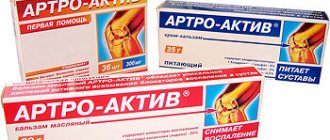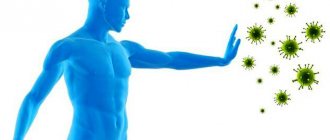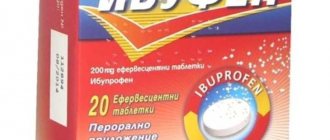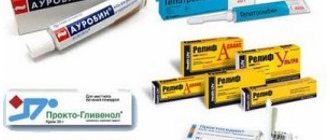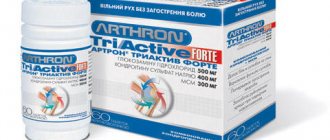Release form and composition
Dosage forms:
- solution for intramuscular administration: ampoule A - transparent, light yellow or colorless; ampoule B (solvent) – colorless, transparent; the prepared solution is transparent, light yellow or colorless, has no suspended particles (ampule A, dark glass, 2 ml of concentrate complete with solvent in ampoules B, 1 ml each, 5 sets each in blister packs, in a cardboard pack of 1 or 2 packaging);
- powder for preparing a solution for oral administration: granular, white or white with a slightly creamy tint (in heat-sealed bags made of a combined material of 3.95 g, in a cardboard pack 5, 10, 20 or 30 bags).
Composition of 2 ml of Sustagard Arthro solution (ampule A):
- active substance: sodium chloride of glucosamine sulfate (in terms of dry matter) – 502.5 mg (glucosamine sulfate – 400 mg; sodium chloride – 102.5 mg);
- auxiliary components: lidocaine hydrochloride – 10 mg; sodium disulfite – 2 mg; concentrated hydrochloric acid – up to pH 2–3; water for injection – up to 2 ml.
Composition of 1 ml of solvent (ampule B):
- diethanolamine – 24 mg;
- water for injection – up to 1 ml.
Composition of 4 g powder (1 sachet):
- active substance: glucosamine sulfate sodium chloride – 1884 mg (glucosamine sulfate – 1500 mg);
- auxiliary components: aspartame – 2.5 mg; sorbitol – 2028.5 mg; macrogol 4000 – 10 mg; citric acid monohydrate – 25 mg.
Pharmacological properties
Pharmacodynamics
Sustagard Artro is one of the stimulators of tissue regeneration. It has anti-inflammatory, chondroprotective, stimulating the regeneration of cartilage tissue, anti-catabolic, analgesic and anabolic effects.
The active component of the drug, glucosamine sulfate, is a salt of the natural aminomonosaccharide glucosamine, physiologically contained in the body. Glucosamine stimulates the synthesis of proteoglycans (hyaluronic acid and glycosaminoglycans) of synovial fluid by chondrocytes; inhibits enzymes (including phospholipase A2, collagenase) leading to the destruction of cartilage tissue; suppresses the activity of lysosomal enzymes, prevents the formation of superoxide radicals; promotes normal calcium deposition in bone tissue and initiates the process of sulfur fixation in the synthesis of chondroitinsulfuric acid; prevents disruption of glycosaminoglycan synthesis induced by non-steroidal anti-inflammatory drugs and the damaging effect of corticosteroids on chondrocytes.
Sulfo groups also take part in the metabolism of cartilage tissue and the synthesis of glycosaminoglycans; sulfoesters of side chains in the composition of proteoglycans are necessary for water retention, which helps maintain the elasticity of the cartilage matrix.
For osteoarthritis, glucosamine sulfate stops the destruction of cartilage and reduces the severity of symptoms (usually 2 weeks after the start of therapy, with the clinical effect maintaining for 8 weeks after discontinuation of the drug).
Pharmacokinetics
Glucosamine sulfate quickly passes through biological barriers with subsequent penetration into tissue, mainly articular cartilage.
The half-life of the substance is approximately 60 hours. Excretion occurs mainly by the kidneys.
Analogues of Sustagard
Today it is not difficult to replace the chondroprotector Sustagard with a drug similar in composition or therapeutic effect - there are many equally effective and efficient medications on the pharmaceutical market.
At the very beginning, doctors highlight an effective drug used in the treatment of joint diseases - “Dona”. The presented chondroprotector has a positive effect on the metabolic processes occurring in cartilage and helps restore them.
Medicinal compositions such as Glucosamine and Chondroflex, as well as Sustilak and Teraflex have a similar positive therapeutic effect. But every patient should remember that it is not worthwhile to independently select and use this or that drug to restore the functioning of joints and the structure of cartilage tissue.
Only a doctor should select the medicinal composition, its dosage and prescribe the duration of the course of treatment, based on the results of the examination and examination of the patient.
Contraindications
Injection solution in ampoules Sustagard Artro
Absolute:
- severe renal/hepatic dysfunction, cardiac conduction disorders, acute heart failure, aggravated history of epileptiform seizures (associated with lidocaine included in the drug);
- pregnancy and breastfeeding;
- age under 18 years;
- individual intolerance to the components of the drug.
Relative (diseases/conditions that require caution):
- chronic heart failure;
- arterial hypotension;
- seafood intolerance (associated with an increased likelihood of allergic reactions);
- circulatory failure;
- tendency to malignant hyperthermia;
- renal/hepatic dysfunction;
- arterial hypotension;
- epilepsy;
- respiratory failure;
- cardiac conduction disorders;
- elderly age.
Powder
- phenylketonuria;
- pregnancy and lactation;
- age up to 12 years;
- individual intolerance to the components of the drug.
When the drug should not be used
Contraindications:
- Phenylketonuria (if powder is used);
- Children's age (up to 12 years);
- Pregnancy;
- Active lactation period;
- Immunity to the main active ingredient or any of the auxiliary components.
However, prescribing the drug can sometimes be very difficult. Due to the fact that the medicinal product in injection form contains lidocaine, the medicinal product is not prescribed for the following conditions:
- Heart failure;
- Problems with cardiac excitability;
- Kidney failure;
- Liver failure;
- Anamnesis aggravated by epileptiform conditions.
Antibiotic drug Panklav
The injection solution is prescribed with extreme caution to patients with the following diseases and pathological conditions:
- Arterial hypotension;
- Lung problems;
- Bronchial ac disease."
Instructions for use of Sustagard Arthro: method and dosage
Concomitant therapy (intramuscular administration and oral administration) is possible.
Injection solution
The drug should be administered intramuscularly only (the drug is not intended for intravenous administration).
The contents of ampoules A and B must be mixed in one syringe immediately before administration. The prepared solution with a volume of 3 ml is administered 3 times a week for a course of 4–6 weeks.
Powder
Sustagard Arthro powder is taken orally, after dissolving the contents of 1 sachet (1.5 g) in 200 ml of water.
The drug is taken once a day for a course of 6 weeks. After 2 months, a second course of treatment may be prescribed.
Analogs
Sustagard Artro may cause allergies. In this case, you will have to choose an analogue. Among the most common suitable drugs, it is worth noting the following drugs:
- Elbona;
- Don;
- Honda Glucosamine Maximum;
- Arthrodok;
- Glucosamine forte.
Do not forget that you cannot select analogues on your own; this is the competence of the doctor.
There are not many reviews about the drug Sustagard Artro on the Internet, but most of them are positive. The effectiveness of the solution for injection is most often noted.
Side effects
- digestive system: diarrhea, flatulence, constipation;
- allergic reactions: itching, urticaria.
Additionally for injection solution (including disorders associated with lidocaine exposure):
- nervous system: headache, disorientation, dizziness, euphoria, tremor, drowsiness, numbness of the tongue and oral mucosa, diplopia;
- cardiovascular system: cardiac conduction disorders;
- digestive system: vomiting, nausea;
- allergic reactions: anaphylactic shock, swelling;
- local reactions: thrombophlebitis, slight burning sensation (disappears within 1 minute after the development of the anesthetic effect);
- others: bronchospasm and severe hypersensitivity reactions (associated with sodium disulfite included in the solution).
Overdose
No cases of overdose have been identified.
Main symptoms (lidocaine hydrochloride reactions): dizziness, tremor, drowsiness, numbness of lips and tongue, depression, blurred vision, restlessness, tinnitus, anxiety.
Therapy is carried out under the control of the function of the respiratory and cardiovascular systems; changes in the corresponding parameters may be a symptom of an overdose, so the patient must immediately be provided with access to oxygen. According to indications, symptomatic treatment is carried out.
special instructions
In patients with impaired glucose tolerance and bronchial asthma, the injection solution should be administered with caution.
If you follow a strict salt-free diet, you need to take into account that 1 dose of solution contains 40.8 mg of sodium.
Before administering the drug, you need to conduct a skin test to determine individual sensitivity to lidocaine (reactions manifest themselves in the form of swelling and redness of the injection site).
Impact on the ability to drive vehicles and complex mechanisms
When using Sustagard Arthro solution when driving vehicles, you should be careful, since lidocaine may have a short-term effect on coordination and motor ability.
Sustagard Arthro (i.m. solution 200 mg/ml amp. 2 ml No. 5 + solution)
A country
Russia
The country of production may vary depending on the batch of goods. Please check with the operator for detailed information when confirming your order.
Active substance
Glucosamine + Ibuprofen + Chondroitin sulfate
Compound
Ampoule A. One ampoule (2ml) contains: active ingredient: glucosamine sulfate sodium chloride (in terms of dry matter) – 502.5 mg (contains glucosamine sulfate – 400 mg, sodium chloride – 102.5 mg) excipients: lidocaine hydrochloride – 10 mg, sodium disulfite – 2 mg, concentrated hydrochloric acid – up to pH 2.0-3.0, water for injection – up to 2 ml. Ampoule B (solvent). One ampoule (1 ml) contains: diethanolamine – 24 mg, water for injection – up to 1 ml.
pharmachologic effect
The drug has stimulating regeneration of cartilage tissue, anabolic, anti-catabolic, chondroprotective, anti-inflammatory, analgesic effects. Glucosamine sulfate, the active component of the drug, is a salt of the natural aminomonosaccharide glucosamine, which is physiologically contained in the body. Glucosamine stimulates the synthesis of proteoglycans (glucosaminoglycans and hyaluronic acid) in synovial fluid by chondrocytes; inhibits enzymes (collagenase, phospholipase A2, etc.) that cause destruction of cartilage tissue; prevents the formation of superoxide radicals, suppresses the activity of lysosomal enzymes; initiates the process of sulfur fixation in the synthesis of chondroitinsulfuric acid and promotes normal calcium deposition in bone tissue; prevents the damaging effect of corticosteroids on chondrocytes and the disruption of glycosaminoglycan synthesis induced by non-steroidal anti-inflammatory drugs. Sulfo groups also take part in the synthesis of glycosaminoglycans and the metabolism of cartilage tissue, and sulfoesters of side chains in the composition of proteoglycans, promoting water retention - in maintaining the elasticity of the cartilage matrix. Glucosamine sulfate stops the destruction of cartilage and reduces symptoms of osteoarthritis. A decrease in clinical symptoms usually appears 2 weeks after the start of treatment, with clinical improvement remaining for 8 weeks after discontinuation of the drug. After intramuscular administration of glucosamine sulfate, it quickly passes through biological barriers and penetrates tissue, mainly articular cartilage. The half-life T is about 60 hours and is excreted mainly by the kidneys.
Indications for use
Primary and secondary osteoarthrosis, osteochondrosis, spondyloarthrosis.
Mode of application
For intramuscular use only! The drug is not intended for intravenous administration. Immediately before administration, mix the contents of ampoule A with ampoule B (solvent) in one syringe. The prepared solution (3 ml) is administered intramuscularly 3 times a week for 4-6 weeks. Injections of the drug can be combined with oral glucosamine.
Interaction
Glucosamine sulfate is compatible with non-steroidal anti-inflammatory drugs, paracetamol and glucocorticosteroids. The drug contains the excipient lidocaine. Cimetidine, peptidine, bupivacaine, propranolol, quinidine, disopyramide, amitriptyline, nortriptyline, chlorpromazine, imipramine increase the level of lidocaine in the blood plasma, reducing its hepatic metabolism. When used simultaneously with class IA antiarrhythmic drugs (including quinidine, procainamide, disopyramide), the QT interval is prolonged, and in very rare cases, AV block or ventricular fibrillation may develop. When used simultaneously with sedatives, the calming effect is enhanced. Phenytoin enhances the cardiodepressive effect of lidocaine. When used simultaneously with procainamide, delusions and hallucinations are possible. Lidocaine may enhance the effect of drugs that block neuromuscular transmission, since the latter reduce the conduction of nerve impulses. Ethanol enhances the inhibitory effect of lidocaine on breathing.
Side effect
From the digestive system: flatulence, diarrhea, constipation. Allergic reactions: urticaria, itching. Local reactions: slight burning sensation (disappears with the development of an anesthetic effect within 1 min), thrombophlebitis. Due to the lidocaine included in the drug, adverse reactions characteristic of of this component from the digestive system: nausea, vomiting; from the nervous system: numbness of the tongue and oral mucosa, drowsiness, diplopia, headache, dizziness, tremor, euphoria, disorientation; from the cardiovascular system: cardiac conduction disorders; allergic reactions: edema, anaphylactic shock. Sodium disulfite, which is part of the drug, can in rare cases cause severe hypersensitivity reactions and bronchospasm.
Contraindications
Hypersensitivity to glucosamine, lidocaine and other components of the drug. Due to the content of lidocaine: cardiac conduction disturbances, acute heart failure, history of epileptiform convulsions, severe dysfunction of the liver and kidneys; period of pregnancy and breastfeeding, childhood and adolescence up to 18 years. With caution: Patients with chronic heart failure, arterial hypotension should use the drug with caution. If you are intolerant to seafood (shrimp, shellfish), the likelihood of developing allergic reactions to the drug increases. Safety of using anesthetics lidocaine group is questionable in patients prone to malignant hyperthermia, so in such cases their use should be avoided. Particular caution should be exercised when using the drug in patients with circulatory insufficiency, arterial hypotension, and impaired liver and/or kidney function. Caution should be exercised when prescribing lidocaine to elderly patients, patients with epilepsy, cardiac conduction disorders, and respiratory failure.
Overdose
No cases of overdose have been identified. The drug contains the excipient lidocaine hydrochloride. The first symptoms of an overdose of lidocaine hydrochloride from the central nervous system may be: numbness of the tongue and lips, agitation, anxiety, tinnitus, dizziness, blurred vision, tremor, depression, drowsiness. It is necessary to monitor the patient's cardiovascular and respiratory functions. A change in these parameters may indicate an overdose of the drug, so the patient should immediately be provided with access to oxygen. All complications require symptomatic treatment.
special instructions
The drug should be prescribed with caution to patients with impaired glucose tolerance. Use with caution when treating patients with bronchial asthma. One dose of the drug contains 40.8 mg of sodium. This should be taken into account when prescribing to patients who are indicated for a strict salt-free diet. Due to the fact that the injection form of the drug includes the excipient lidocaine, before using it it is necessary to conduct a skin test for individual sensitivity to the drug, which may be indicated by swelling and redness of the injection site. The effect of glucosamine on the ability to drive vehicles and machines has not been examined. Please note that the composition contains lidocaine, which may have a temporary effect on motor ability and coordination. During the treatment period, care must be taken when driving vehicles and engaging in other potentially hazardous activities.
Dispensing conditions in pharmacies
On prescription
Drug interactions
Glucosamine sulfate is compatible with non-steroidal anti-inflammatory drugs, paracetamol and glucocorticosteroids. Reduces the absorption of chloramphenicol and penicillins, increases - tetracyclines.
Possible interactions of lidocaine included in the Sustagard Arthro solution:
- class IA antiarrhythmic drugs, including quinidine, procainamide, disopyramide: prolongation of the QT interval, in very rare cases - the occurrence of ventricular fibrillation or AV (atrioventricular) block;
- chlorpromazine, nortriptyline, cimetidine, bupivacaine, peptidine, quinidine, propranolol, amitriptyline, disopyramide, imipramine: increased plasma concentration of lidocaine in the blood, decreased its hepatic metabolism;
- drugs with sedative effects: enhancing the calming effect;
- phenytoin: increased cardiodepressive effect of lidocaine;
- procainamide: development of hallucinations, delusions;
- ethanol: increased inhibitory effect of lidocaine on breathing;
- drugs that block neuromuscular transmission: enhancing their effect.
Interaction of the drug with other medicinal substances
The active substance of the drug "Sustagard" does not interact with other drugs, so it is safe to include it in treatment regimens for various joint diseases along with non-steroidal anti-inflammatory drugs and glucocorticosteroids.
Drug interactions with Sustagard may be due to the presence of lidocaine in its composition. Cimetidine, Bupivacaine, Propranolol, Quinidine, Disopyramide, Amitriptyline, Chlorpromazine can increase the concentration of lidocaine in the blood plasma by reducing the intensity of its metabolism in liver cells. In the case of a combination with antiarrhythmic drugs, for example with Quinidine or Procainamide, a prolongation of the QT interval on the electrocardiogram may occur, as well as the development of AV block or ventricular fibrillation, up to cardiac arrest.
Also, combination with Procainamide can lead to the development of psychotic reactions, delusions and hallucinations. The drug enhances the sedative effect of sedatives.
The use of Phenytoin during therapy with Sustagard can lead to a decrease in the frequency and strength of heart contractions.
During the period of using Sustagard, the consumption of alcoholic beverages is prohibited, since the combination of ethanol with lidocaine has a depressant effect on breathing.

